Page 1019 of 4133
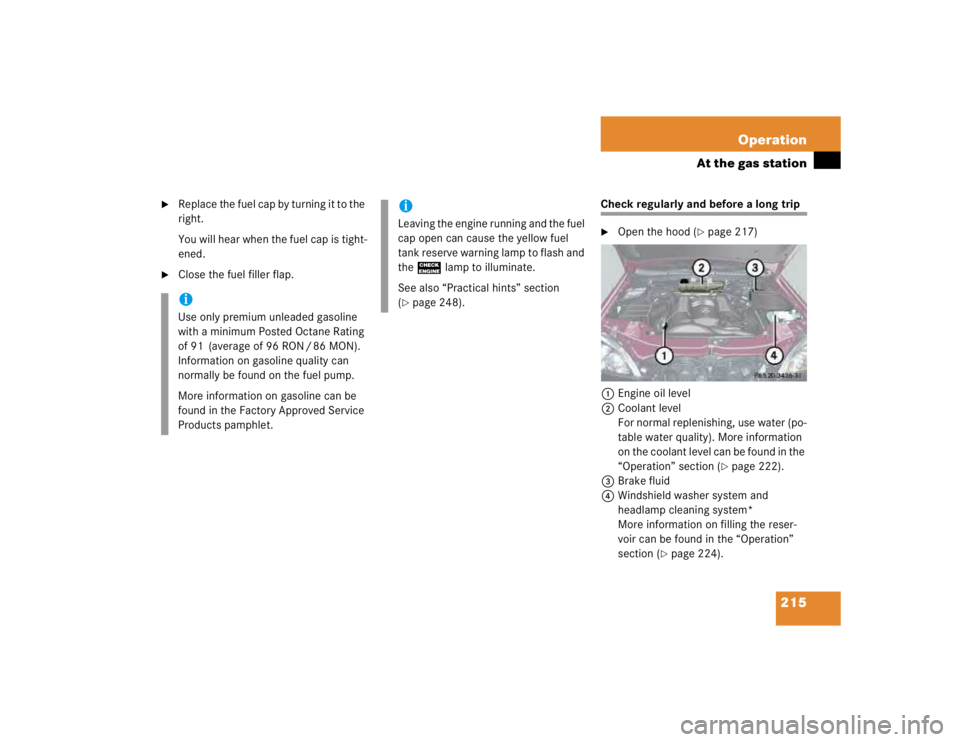
215 Operation
At the gas station
�
Replace the fuel cap by turning it to the
right.
You will hear when the fuel cap is tight-
ened.
�
Close the fuel filler flap.
Check regularly and before a long trip�
Open the hood (
�page 217)
1Engine oil level
2Coolant level
For normal replenishing, use water (po-
table water quality). More information
on the coolant level can be found in the
“Operation” section (
�page 222).
3Brake fluid
4Windshield washer system and
headlamp cleaning system*
More information on filling the reser-
voir can be found in the “Operation”
section (
�page 224).
iUse only premium unleaded gasoline
with a minimum Posted Octane Rating
of 91 (average of 96 RON / 86 MON).
Information on gasoline quality can
normally be found on the fuel pump.
More information on gasoline can be
found in the Factory Approved Service
Products pamphlet.
iLeaving the engine running and the fuel
cap open can cause the yellow fuel
tank reserve warning lamp to flash and
the? lamp to illuminate.
See also “Practical hints” section
(�page 248).
Page 1020 of 4133
216 OperationAt the gas stationEngine oil level
More information on engine oil see “Engine
oil” (
�page 218).Vehicle lighting
Check function and cleanliness. More in-
formation on replacing light bulbs can be
found in the “Practical hints” section
(
�page 266).
Tire inflation pressure
More information on tire inflation pressure
can be found in the “Operation” section
(�page 227).
!If you find that the brake fluid in the
brake fluid reservoir has fallen to the
minimum mark or below, have the
brake system checked for brake pad
thickness and leaks immediately. Noti-
fy an authorized Mercedes-Benz Light
Truck Center immediately. Do not add
brake fluid as this will not solve the
problem. For more information, see
“Practical Hints” (
�page 245).
Page 1022 of 4133
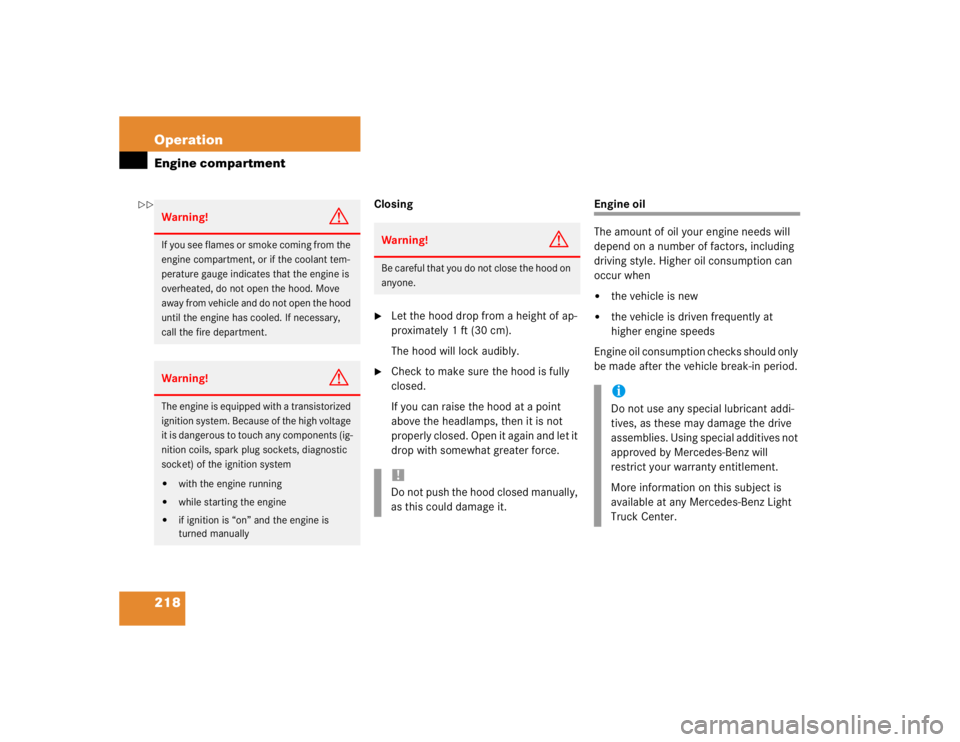
218 OperationEngine compartment
Closing�
Let the hood drop from a height of ap-
proximately 1 ft (30 cm).
The hood will lock audibly.
�
Check to make sure the hood is fully
closed.
If you can raise the hood at a point
above the headlamps, then it is not
properly closed. Open it again and let it
drop with somewhat greater force.
Engine oil
The amount of oil your engine needs will
depend on a number of factors, including
driving style. Higher oil consumption can
occur when�
the vehicle is new
�
the vehicle is driven frequently at
higher engine speeds
Engine oil consumption checks should only
be made after the vehicle break-in period.
Warning!
G
If you see flames or smoke coming from the
engine compartment, or if the coolant tem-
perature gauge indicates that the engine is
overheated, do not open the hood. Move
away from vehicle and do not open the hood
until the engine has cooled. If necessary,
call the fire department.Warning!
G
The engine is equipped with a transistorized
ignition system. Because of the high voltage
it is dangerous to touch any components (ig-
nition coils, spark plug sockets, diagnostic
socket) of the ignition system�
with the engine running
�
while starting the engine
�
if ignition is “on” and the engine is
turned manually
Warning!
G
Be careful that you do not close the hood on
anyone.!Do not push the hood closed manually,
as this could damage it.
iDo not use any special lubricant addi-
tives, as these may damage the drive
assemblies. Using special additives not
approved by Mercedes-Benz will
restrict your warranty entitlement.
More information on this subject is
available at any Mercedes-Benz Light
Truck Center.
��
Page 1023 of 4133
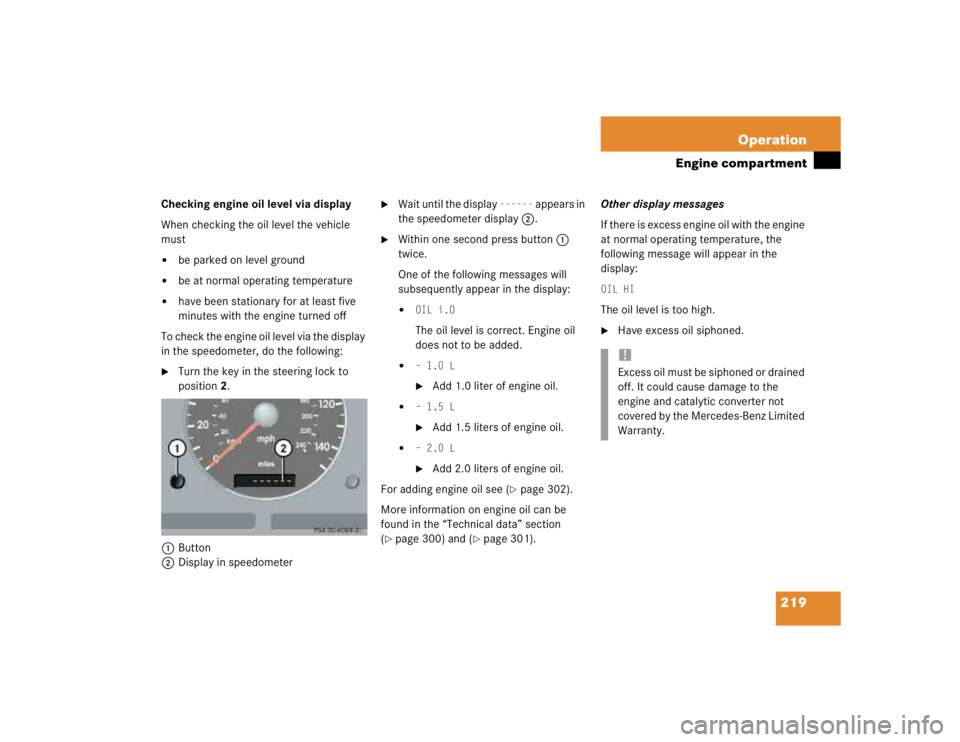
219 Operation
Engine compartment
Checking engine oil level via display
When checking the oil level the vehicle
must�
be parked on level ground
�
be at normal operating temperature
�
have been stationary for at least five
minutes with the engine turned off
To check the engine oil level via the display
in the speedometer, do the following:
�
Turn the key in the steering lock to
position2.
1Button
2Display in speedometer
�
Wait until the display
------
appears in
the speedometer display2.
�
Within one second press button1
twice.
One of the following messages will
subsequently appear in the display:�
OIL i.OThe oil level is correct. Engine oil
does not to be added.
�
– 1.0 L�
Add 1.0 liter of engine oil.
�
– 1.5 L�
Add 1.5 liters of engine oil.
�
– 2.0 L�
Add 2.0 liters of engine oil.
For adding engine oil see (
�page 302).
More information on engine oil can be
found in the “Technical data” section
(
�page 300) and (
�page 301).Other display messages
If there is excess engine oil with the engine
at normal operating temperature, the
following message will appear in the
display:
OIL HIThe oil level is too high.�
Have excess oil siphoned.!Excess oil must be siphoned or drained
off. It could cause damage to the
engine and catalytic converter not
covered by the Mercedes-Benz Limited
Warranty.
Page 1024 of 4133
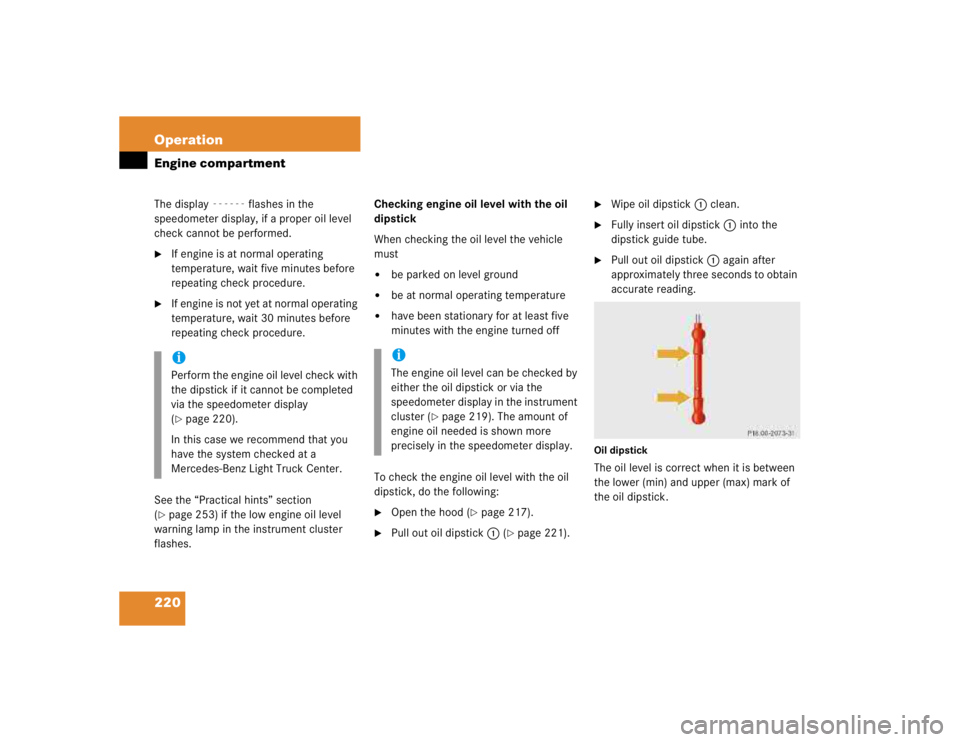
220 OperationEngine compartmentThe display
------
flashes in the
speedometer display, if a proper oil level
check cannot be performed.
�
If engine is at normal operating
temperature, wait five minutes before
repeating check procedure.
�
If engine is not yet at normal operating
temperature, wait 30 minutes before
repeating check procedure.
See the “Practical hints” section
(
�page 253) if the low engine oil level
warning lamp in the instrument cluster
flashes.Checking engine oil level with the oil
dipstick
When checking the oil level the vehicle
must
�
be parked on level ground
�
be at normal operating temperature
�
have been stationary for at least five
minutes with the engine turned off
To check the engine oil level with the oil
dipstick, do the following:
�
Open the hood (
�page 217).
�
Pull out oil dipstick1 (
�page 221).
�
Wipe oil dipstick1 clean.
�
Fully insert oil dipstick1 into the
dipstick guide tube.
�
Pull out oil dipstick1 again after
approximately three seconds to obtain
accurate reading.
Oil dipstickThe oil level is correct when it is between
the lower (min) and upper (max) mark of
the oil dipstick.
iPerform the engine oil level check with
the dipstick if it cannot be completed
via the speedometer display
(�page 220).
In this case we recommend that you
have the system checked at a
Mercedes-Benz Light Truck Center.
iThe engine oil level can be checked by
either the oil dipstick or via the
speedometer display in the instrument
cluster (
�page 219). The amount of
engine oil needed is shown more
precisely in the speedometer display.
Page 1025 of 4133
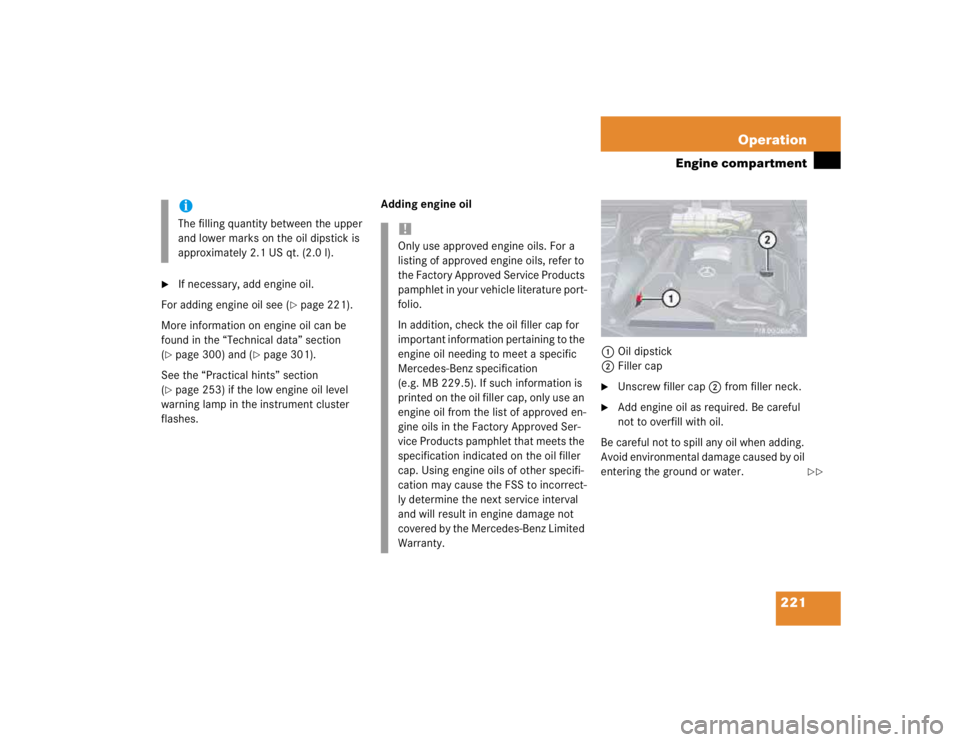
221 Operation
Engine compartment
�
If necessary, add engine oil.
For adding engine oil see (
�page 221).
More information on engine oil can be
found in the “Technical data” section
(
�page 300) and (
�page 301).
See the “Practical hints” section
(
�page 253) if the low engine oil level
warning lamp in the instrument cluster
flashes.Adding engine oil
1Oil dipstick
2Filler cap
�
Unscrew filler cap2 from filler neck.
�
Add engine oil as required. Be careful
not to overfill with oil.
Be careful not to spill any oil when adding.
Avoid environmental damage caused by oil
entering the ground or water.
iThe filling quantity between the upper
and lower marks on the oil dipstick is
approximately 2.1 US qt. (2.0 l).
!Only use approved engine oils. For a
listing of approved engine oils, refer to
the Factory Approved Service Products
pamphlet in your vehicle literature port-
folio.
In addition, check the oil filler cap for
important information pertaining to the
engine oil needing to meet a specific
Mercedes-Benz specification
(e.g. MB 229.5). If such information is
printed on the oil filler cap, only use an
engine oil from the list of approved en-
gine oils in the Factory Approved Ser-
vice Products pamphlet that meets the
specification indicated on the oil filler
cap. Using engine oils of other specifi-
cation may cause the FSS to incorrect-
ly determine the next service interval
and will result in engine damage not
covered by the Mercedes-Benz Limited
Warranty.
��
Page 1026 of 4133
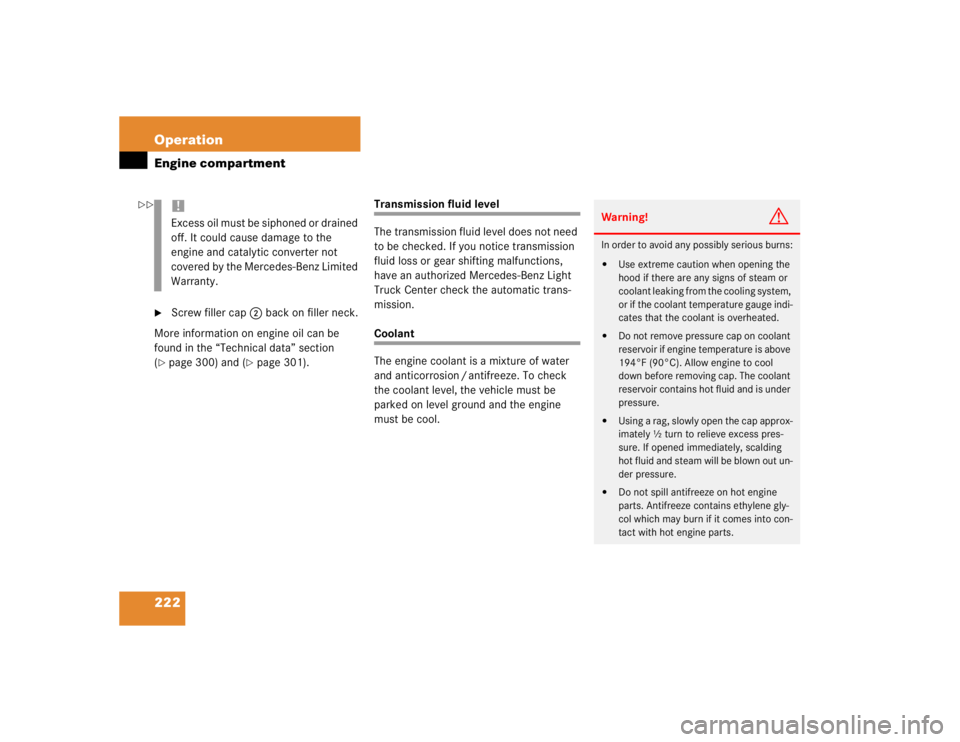
222 OperationEngine compartment�
Screw filler cap2 back on filler neck.
More information on engine oil can be
found in the “Technical data” section
(
�page 300) and (
�page 301).
Transmission fluid level
The transmission fluid level does not need
to be checked. If you notice transmission
fluid loss or gear shifting malfunctions,
have an authorized Mercedes-Benz Light
Truck Center check the automatic trans-
mission.Coolant
The engine coolant is a mixture of water
and anticorrosion / antifreeze. To check
the coolant level, the vehicle must be
parked on level ground and the engine
must be cool.
!Excess oil must be siphoned or drained
off. It could cause damage to the
engine and catalytic converter not
covered by the Mercedes-Benz Limited
Warranty.
Warning!
G
In order to avoid any possibly serious burns:�
Use extreme caution when opening the
hood if there are any signs of steam or
coolant leaking from the cooling system,
or if the coolant temperature gauge indi-
cates that the coolant is overheated.
�
Do not remove pressure cap on coolant
reservoir if engine temperature is above
194°F (90°C). Allow engine to cool
down before removing cap. The coolant
reservoir contains hot fluid and is under
pressure.
�
Using a rag, slowly open the cap approx-
imately ½ turn to relieve excess pres-
sure. If opened immediately, scalding
hot fluid and steam will be blown out un-
der pressure.
�
Do not spill antifreeze on hot engine
parts. Antifreeze contains ethylene gly-
col which may burn if it comes into con-
tact with hot engine parts.
��
Page 1031 of 4133
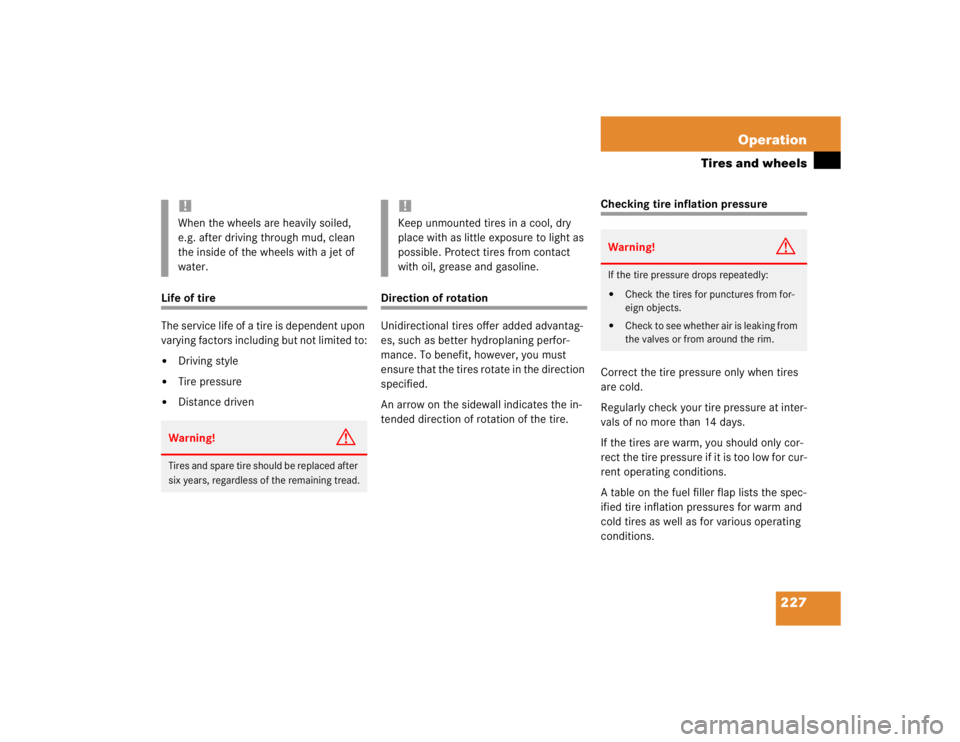
227 Operation
Tires and wheels
Life of tire
The service life of a tire is dependent upon
varying factors including but not limited to:�
Driving style
�
Tire pressure
�
Distance driven
Direction of rotation
Unidirectional tires offer added advantag-
es, such as better hydroplaning perfor-
mance. To benefit, however, you must
ensure that the tires rotate in the direction
specified.
An arrow on the sidewall indicates the in-
tended direction of rotation of the tire.
Checking tire inflation pressure
Correct the tire pressure only when tires
are cold.
Regularly check your tire pressure at inter-
vals of no more than 14 days.
If the tires are warm, you should only cor-
rect the tire pressure if it is too low for cur-
rent operating conditions.
A table on the fuel filler flap lists the spec-
ified tire inflation pressures for warm and
cold tires as well as for various operating
conditions.
!When the wheels are heavily soiled,
e.g. after driving through mud, clean
the inside of the wheels with a jet of
water.Warning!
G
Tires and spare tire should be replaced after
six years, regardless of the remaining tread.
!Keep unmounted tires in a cool, dry
place with as little exposure to light as
possible. Protect tires from contact
with oil, grease and gasoline.
Warning!
G
If the tire pressure drops repeatedly:�
Check the tires for punctures from for-
eign objects.
�
Check to see whether air is leaking from
the valves or from around the rim.